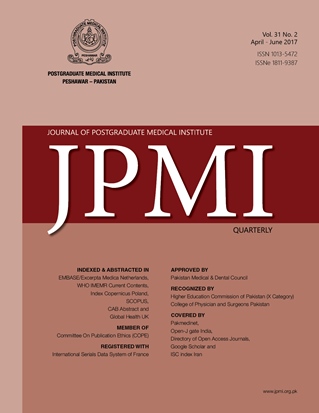EFFECTS OF THYROIDAL DYSFUNCTIONS ON BONE MARKERS IN NON-PREGNANT WOMEN: A HOSPITAL BASED CROSS SECTIONAL STUDY FROM KHYBER PAKHTUNKHWA NORTHERN PAKISTAN
Main Article Content
Abstract
Objective: To study the ill effects of thyroid dysfunctions on biochemical markers
of bone formation in non-pregnant women (NPW) of Khyber Pakhtunkhaw
in Northern Pakistan.
Methodology: This cross sectional study was conducted in Khyber Teaching
Hospital. The study group comprised of 258 non-pregnant women in the age
range of 18-75 years. Thyroid profile was determined by Elisa methods for all
the patients. Serum level of alkaline phosphatase (ALP), calcium and zinc were
also determined using standard protocols and the data was analyzed statistically,
using SPSS version 21.
Results: Mean serum calcium was highest in overtly hyperthyroid (OH) group
(9.80 ±0.90mg/dl) and lowest in overtly hypothyroid (Oh) group (8.95± 0.10
mg/ dl). Serum total alkaline phosphatase was found to be maximum in normal
(N) group (159± 7.61 U/l) and minimum in sub clinically hypothyroid (Sh) group
(128± 6.42 U/l). There were no significant differences in the serum zinc (Zn)
level of all the diseased groups. Calcium showed significant positive correlation
with TSH in Oh (p=0.01) and OH (p=0.04). Serum calcium was significantly
negatively correlated with T3 in OH (p=0.01). Serum alkaline phosphatase was
significantly negatively related with T4 in OH (p=0.01). Serum Zn showed a very
significant positive correlation with T3 in sub-clinical hyperthyroid (SH) (p=0.02).
Conclusions: Thyroid dysfunctions may disturb bone formation and resorption
equilibrium.
of bone formation in non-pregnant women (NPW) of Khyber Pakhtunkhaw
in Northern Pakistan.
Methodology: This cross sectional study was conducted in Khyber Teaching
Hospital. The study group comprised of 258 non-pregnant women in the age
range of 18-75 years. Thyroid profile was determined by Elisa methods for all
the patients. Serum level of alkaline phosphatase (ALP), calcium and zinc were
also determined using standard protocols and the data was analyzed statistically,
using SPSS version 21.
Results: Mean serum calcium was highest in overtly hyperthyroid (OH) group
(9.80 ±0.90mg/dl) and lowest in overtly hypothyroid (Oh) group (8.95± 0.10
mg/ dl). Serum total alkaline phosphatase was found to be maximum in normal
(N) group (159± 7.61 U/l) and minimum in sub clinically hypothyroid (Sh) group
(128± 6.42 U/l). There were no significant differences in the serum zinc (Zn)
level of all the diseased groups. Calcium showed significant positive correlation
with TSH in Oh (p=0.01) and OH (p=0.04). Serum calcium was significantly
negatively correlated with T3 in OH (p=0.01). Serum alkaline phosphatase was
significantly negatively related with T4 in OH (p=0.01). Serum Zn showed a very
significant positive correlation with T3 in sub-clinical hyperthyroid (SH) (p=0.02).
Conclusions: Thyroid dysfunctions may disturb bone formation and resorption
equilibrium.
Article Details
How to Cite
1.
Shah J, Jan MR, Yousaf M. EFFECTS OF THYROIDAL DYSFUNCTIONS ON BONE MARKERS IN NON-PREGNANT WOMEN: A HOSPITAL BASED CROSS SECTIONAL STUDY FROM KHYBER PAKHTUNKHWA NORTHERN PAKISTAN. J Postgrad Med Inst [Internet]. 2017 May 12 [cited 2025 Dec. 5];31(2). Available from: https://jpmi.org.pk/index.php/jpmi/article/view/2038
Issue
Section
Original Article
Work published in JPMI is licensed under a
Creative Commons Attribution-NonCommercial 2.0 Generic License.
Authors are permitted and encouraged to post their work online (e.g., in institutional repositories or on their website) prior to and during the submission process, as it can lead to productive exchanges, as well as earlier and greater citation of published work.


